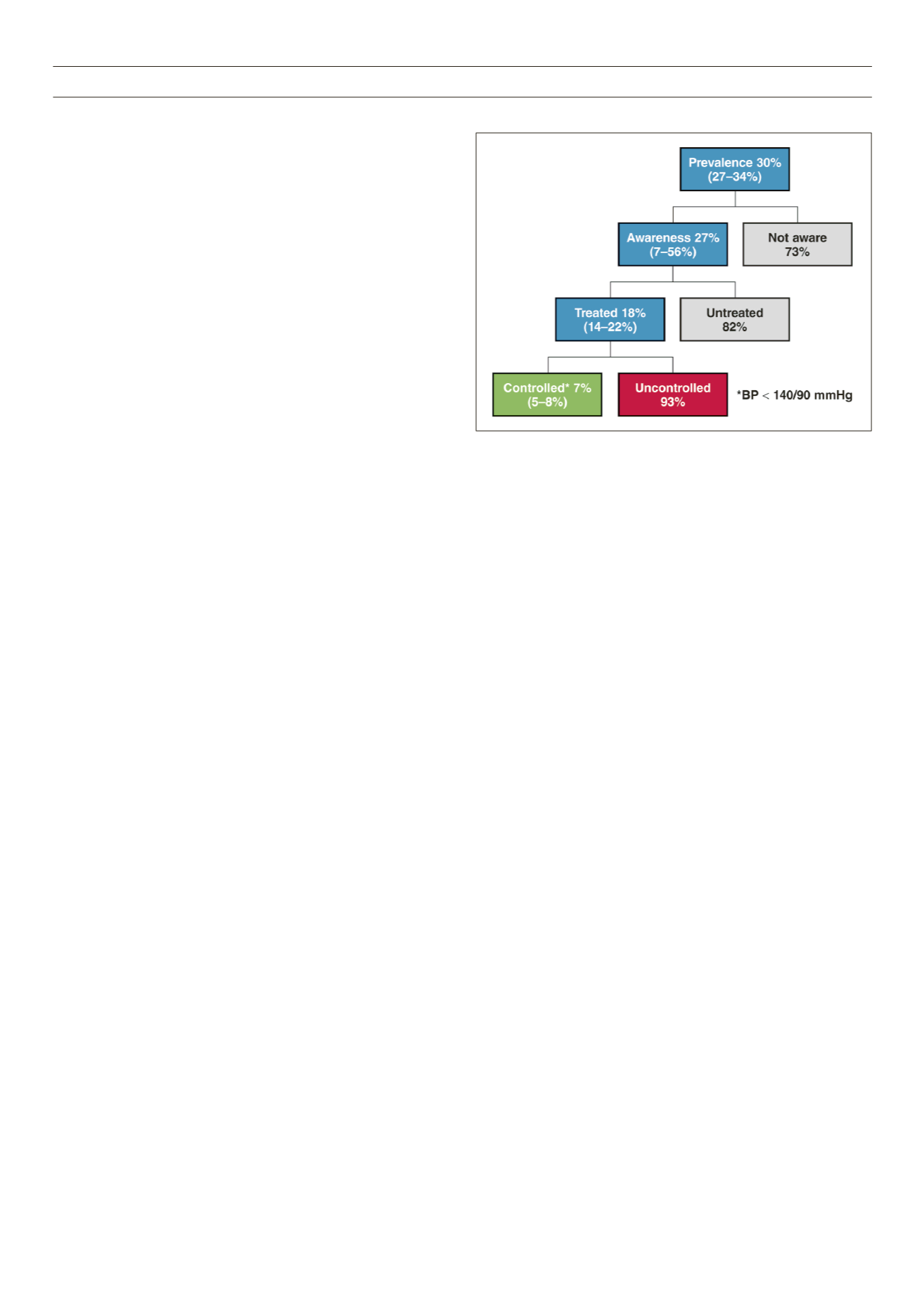

VOLUME 15 NUMBER 2 • NOVEMBER 2018
79
SA JOURNAL OF DIABETES & VASCULAR DISEASE
PASCAR ROADMAP
progressively available and affordable in Africa. We also encourage
face-to-face education by traditional and religious leaders.
The discrepancy between best practice (based on highquality
evidence) and the care provided in routine clinical practice is called
the ‘care gap’. This includes situations in which interventions with
proven efficacy are under-utilised. This description is most marked
in Africa, where it is favoured by poverty and inadequate utilisation
of existing resources. Despite strong evidence of the management
benefit, this can reflect as poor awareness and control of CVD rates
or risk factors.
Current data on awareness and hypertension control rates in
SSA are from a wide range of studies differing in methodology
and limiting the opportunity for reliable comparisons. However,
available data show that the high prevalence of hypertension
in Africa, as in other LMICs, is coupled with low awareness and
control rates (Fig. 3), a reflection of a maximal care gap.
5-8
In 2011, UN member states acknowledged at the highest
international level that premature deaths from NCDs reduce
productivity and curtail economic growth, causing significant social
challenges in most countries.
9
In 2015, the previous target of 25%
reduction in rate of premature mortality from NCDs by 2025 was
extended to a reduction of 33% by 2030, through prevention,
treatment and promotion of mental health and wellbeing.
10
Since 2004, the African Union, in a pro-active approach, named
hypertension one of the continent’s greatest health challenges after
HIV/AIDS. After more than a decade, this political enthusiasm, which
is crucial for the development and implementation of any healthcare
policy, has yet to be translated into public health action. The role
of hypertension experts is key to facilitate the states’ action to
adequately contain this threat. In a simple and practical hypertension
policy, the PASCAR approach emphasises working in collaboration
with all other stakeholders to set clear goals and define priority
actions and minimum standards of African healthcare systems.
The World Heart Federation roadmap and other
relevant initiatives
As part of the WHO’s target in reducing heart attacks and stroke
by 2025, the World Heart Federation (WHF) launched a roadmap
focusing on raised BP during the 2015 World Health Assembly
in Geneva.
11
Herein the routes are described towards reducing
premature cardiovascular mortality rate by 25%,
11
focusing on
presenting practical steps for hypertension control. For effective
hypertension control, four population groups were identified:
people who are unaware of their BP status; those who are aware
of having raised BP but it is uncontrolled; those who are aware of
their raised BP, which is under control; and those who are aware of
having normal BP.
After identifying the target population, practical steps are
provided for improving hypertension management. These include
opportunistic screening for awareness of BP status and effective
drug treatment for high BP.
The use of generic antihypertensive medications rather than
proprietary medications is encouraged, to substantially reduce the
cost of care, but with a caveat for the need to ensure quality generic
medications. Bearing in mind the holistic nature of healthcare
delivery, this initiative identified health-system requirements to
achieve BP management targets and include human, physical and
intellectual resources, healthcare delivery, healthcare recipients,
financing, and governance and information systems.
With global information technology tools available, the
suggestion of using e-health, particularly m-health, for patient
education is a very feasible approach in the guidelines. If well
applied, this could be a useful tool in hypertension control. This
roadmap is anticipated to substantially bridge the gap between HIC
and LMIC in terms of hypertension management and control policy.
The WHO Package of Essential Non-communicable (PEN) Disease
Interventions for Primary Healthcare in Low-Resource Settings is
an integrated approach to NCDs focusing exclusively on primary
healthcare in low-resource settings.
12
The WHF roadmap provides a global framework to reduce
CVD mortality, focusing on evidence-based interventions. Strong
emphasis is placed on health systems, cost-effectiveness and
subsequent evaluation of programmes. Hypertension as a single
risk factor, and an entry point to prevent CVD rather than the
absolute-risk approach, provides a framework to identify roadblocks
in implementing evidence-based interventions. Hypertension
seldom occurs in isolation, co-existing with other CVD risk factors,
contributing to the absolute-risk status.
The PASCAR roadmap strongly emphasises hypertension as a
global health crisis and major threat. We hope that hypertension
screeningwill increase in the next eight years, resulting in a paradoxical
increase in the prevalence of hypertension. For this reason, the task
force’s target is to increase treatment and control rates among the
treated subjects by 25% in the SSA region by 2025.
We identified roadblocks to the control of hypertension in the
African region and proposed solutions to these roadblocks, thus
defining the best strategy to achieve this in SSA. Because the epidemic
of NCDs is driven by globalisation, urbanisation, demographic trends
and socio-economic conditions,
13
interventions to reach our targets
are required from the health sector and other governmental sectors,
along with civil society and the private sector.
Therefore, guidance is provided for policy makers, healthcare
professionals (nurses, general practitioners, familydoctors, internists,
cardiologists, nephrologists and other hypertension specialists),
patients, the private sector and the public, including civil society,
on controlling hypertension to reduce premature mortality from
CVD. To guide the action of stakeholders, we also highlight the
Fig. 3.
Prevalence, awareness, treatment and control of hypertension in Africa.
Numbers are from Ataklte
et al
. Burden of undiagnosed hypertension in sub-
Saharan Africa: A systematic review and meta-analysis.
5



















